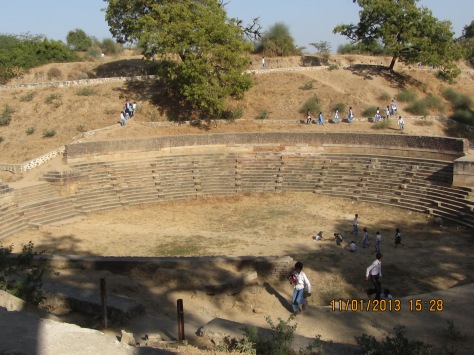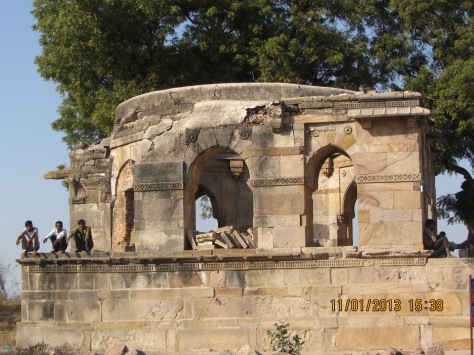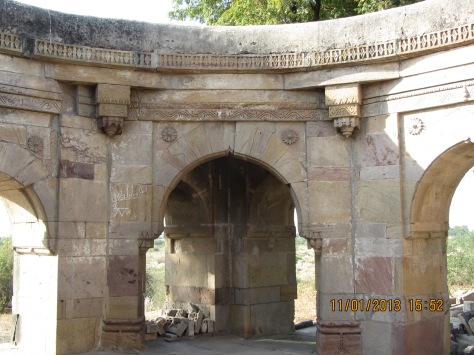It is worth waking up at dawn if your destination is Patan, the seat of the kings who ruled Gujarat for a long time. It hurts me now to admit that I know next to nothing about the history, but my half a day visit to some magnificent ruins have kindled that curiosity in me. Will improve this piece once I know more, but फिलहाल ये ही सही।
Sharing with you what struck me on this whirl-wind visit which ended with me promising myself to return:
My first encounter happened with the Maya ni Tekri. On the web, I found some reference to Maya Bhagat (Maya the devotee) who belonged to the class of untouchables in the time when Sidhharaj Solanki was the king. In the typical story-within-the-story fashion, my hostess, Bhavana Soni told me that King Siddharaj Jaysinh (Sadhro Jesang in the local dialect) was in a difficult position, because the ambitious Sahastraling reservoir he had built was cursed to never have water, by a woman named Jasma (her story, soon) whom he harassed. Jasma immolated herself like a Sati after her handicapped husband who was put to death at the king’s command. The king was advised by some men that sacrificing a perfect man could reverse the curse. As the luck or maneuvering would have it, only Maya the untouchable had these qualities. Maya being a Bhagat – someone who was simple, devoted to God and did not have much interest in the worldly affairs, agreed to being sacrificed – but at a condition. His condition was that the people of his class should be treated with dignity and the oppressive restrictions placed on them should be removed. As per the prevailing norms, the untouchables had to wear distinguishing head gear, they could not spit at will, and had to tie a broom at their back so as to remove their footprints. The king agreed, and Maya sacrificed himself for the water in the reservoir. One wonders if he knew what the city of Patan was fated to have – because the reservoir never sustained water.
So, what was the Jasma story? I remember having read its Amar Chitrakatha version. If I remember correctly, Jasma was very, very beautiful woman of the Od community. The ods were nomadic people who moved wherever their work took them, and they largely served as helping hands in construction projects. Jasma, her handicapped husband and their community were in Patan, working for the king Siddhraj’s ambitious Sahastraling project. It was more than just a reservoir – it was a complex web of water inlets, channels and repositories, along which there were a thousand (sahastra) shiv temples. I remember having heard that at Sandhya time, when all the thousand shiv temples were lit up with lamps as the Arati was performed, the atmosphere transformed to something ethereal.
Well, coming back to its making – once Siddhraj saw Jasma on the site and became enamored by her beauty. He made advances to Jasma. Jasma, in a sagely fashion, observed, “રાજા, આ તારી આંખ નથી ફરતી, તારો દિ’ ફર્યો છે.” (it’s not your eye that’s wandering, but your doom is lurking) Looking at the glorious record of the King, it was quite a harbinger of his downfall. Anyway, the king refused to consider the warning as serious and continued to chase Jasma. In a train of events, the men in Jasma’s community die guarding her honor, her husband was killed and Jasma, in the fashion of Sati, immolated herself, with her husband’s head in her lap.
There is a temple built in memory of Jasma, very close to a section of the Sahastraling ruins. I had time only to visit the Rudra Koop section of the Sahastraling.
It is close to the river Saraswati, now believed to be underground (there is a story for that, too). Walking along the water channels would have been wonderful, and I am going to visit the site again for that!!
The complexity of the architecture and the lack of my photography skills put a full stop on clicking at this site. more, soon!!!
From this place, little away and across the ‘river’, there is a site of several tombs. It is difficult to tell if this was the original construction or an existing Hindu structure was broken down by the muslim invaders and converted to the tomb. Some of the motifs are so common across both types of structures that a lay person like me can’t say anything authoritatively. Sharing some pictures above and below. The Archeological Survey of India was carrying out restoration work, but I did not see engineers or architects there.





I suppose my comment led to suspension of further digging at this cemetry. The kitchen can breathe now, though how much can it breath at this depth.
LikeLike
You think too much of your opinion. People have other things to do too, besides writing blogs.
LikeLike
I don’t have to go Patagonia
LikeLike
Oh, if you have a chance, don’t cancel the Patagonia trip!!
LikeLike
That is a hundred-feet deep burial to the previous post.
LikeLike